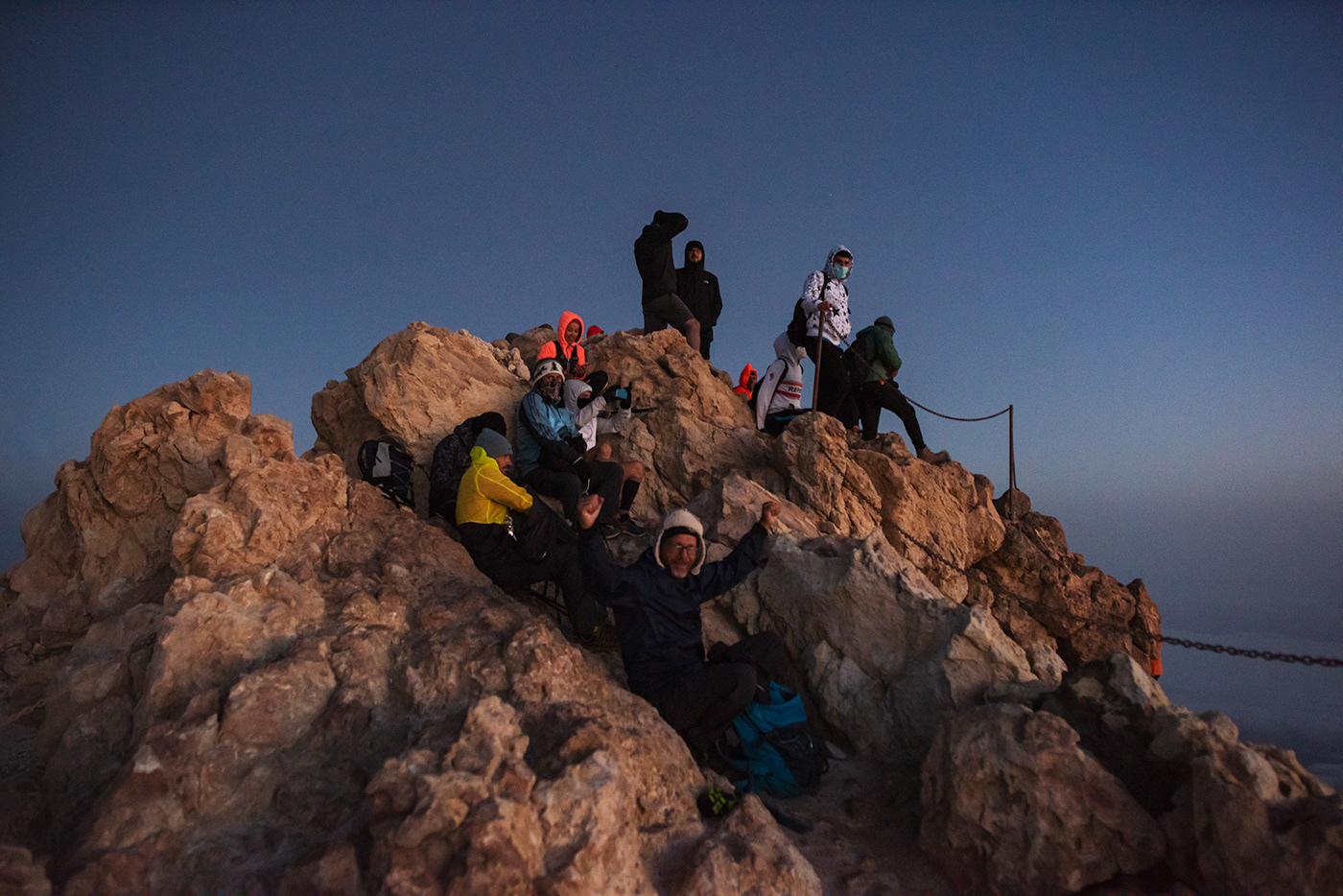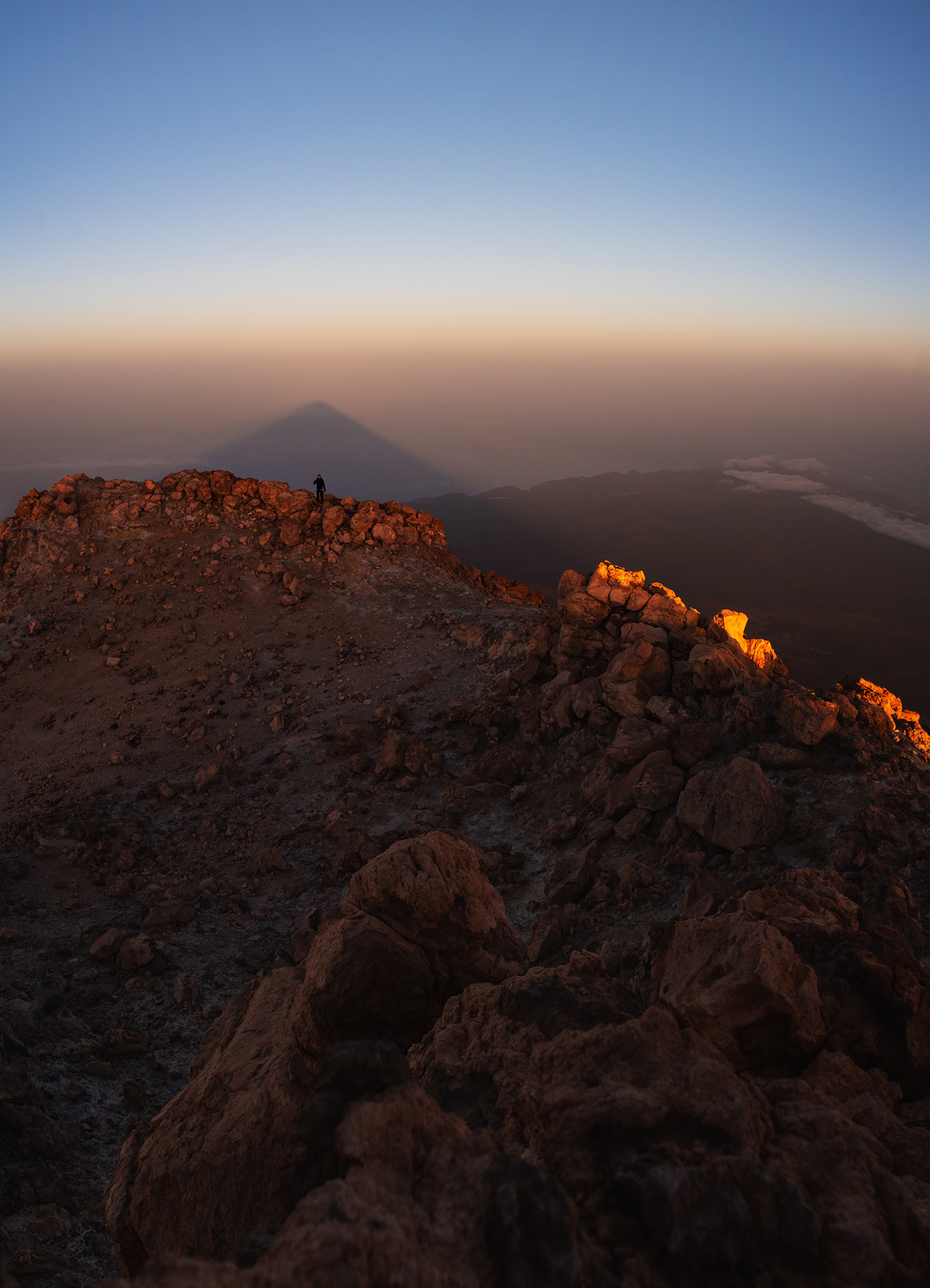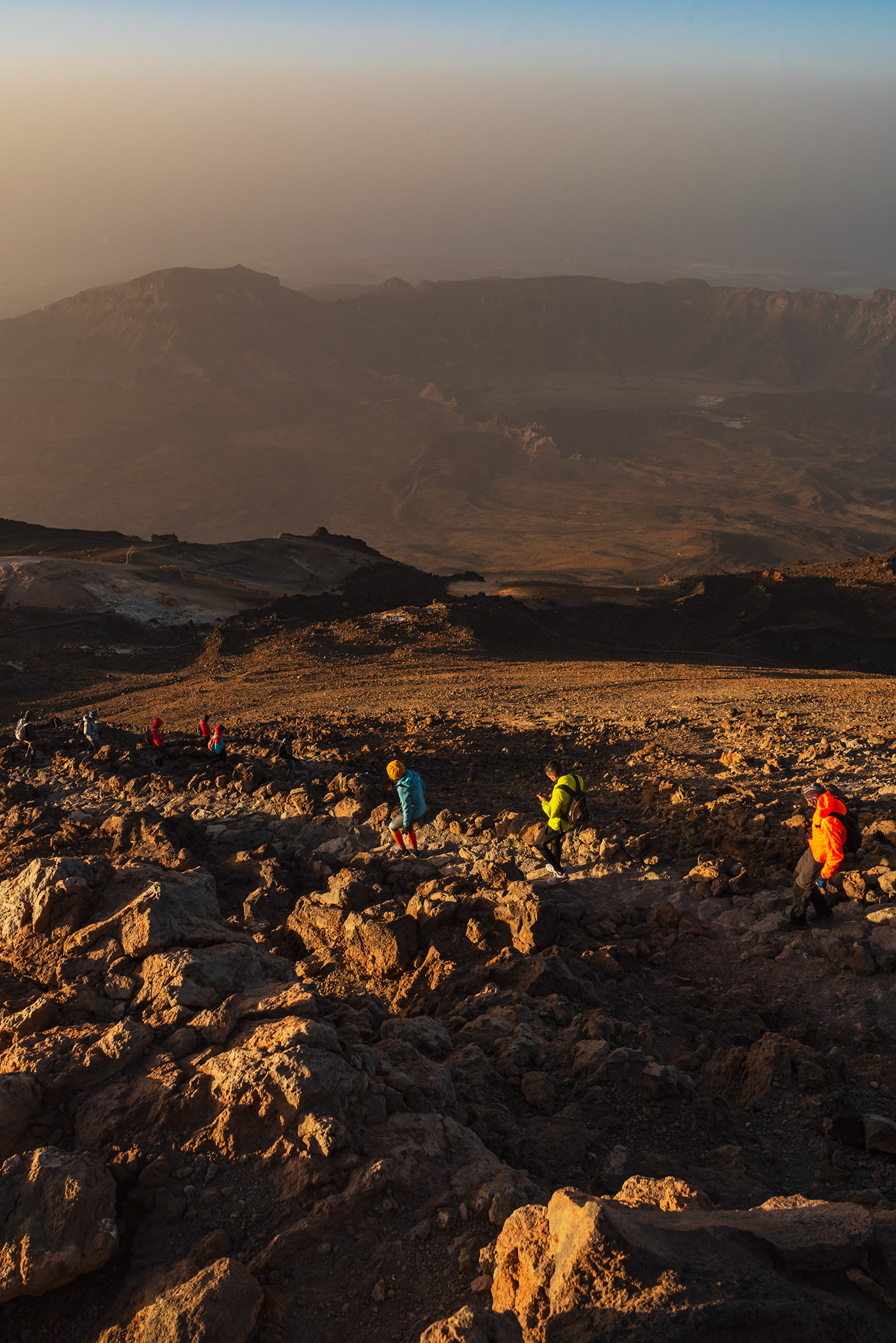
Canary Lullabies - My Cosmic Photo Adventures
Tenerife
2020
In august 2020, I traveled to Tenerife for a nocturnal exploration of the Teide National Park. So far, we had been six months into the covid pandemic while the situation in late July seemed to allow me doing that trip without any risks. With the exception of four additional nights in 2021, this should be the only dedicated astrophotography trip for more then two years and the beginning of the pandemic.
Tenerife is a beloved destination in the Canary Islands for usual tourists and astro- & landscape photographers equally. I never understood why photographers never prefer the neighbor island La Palma, where I spent most of my time for photography since 2017. On my first trip on top of the island into the Caldera de las Cañadas, I should find that answer. That Caldera on an altitude of 2000m, where Spain’s highest mountain - the volcano Pico de Teide - majestically dominates the scenery, offers an alien and diversified landscape in such a great scale, that I got very much overwhelmed without any idea where to start my photo adventure. Nevertheless, things worked out well for me and that experience is still vibing in my mind after one and a half years. Until today, that’s the place where I took my best photographs so far.
The great advantage of Mistakes
To work with a new camera made me feel excited for weeks, especially an H-Alpha astromodified one, that increases the visibility of hydrogen nebulae in the night sky, that appear in a typical red colour. (Find more Infos about h-alpha modification here) Just stupid not to setup the camera format from jpeg to raw - because one is a compressed format with low post possessing options while the raw format gives you all freedom to readjust your settings afterwards, especially the necessary white balance which is shifted into red due to the modification. Applause.
According to this and my narrow understanding of failure and success, I considered all photos from that night as unusable and kind of lesson to myself. And it was one, at least when I some when started to play around with the settings of these very „uneditable“ files. The shift of colours remained, but the strange looking results became more beautiful and I started to like that style. Damn, now this is a lesson… I edited these images to get a solid natural looking foreground and the weird color mix of the sky wasn’t just in my responsibility. It’s just jpeg.
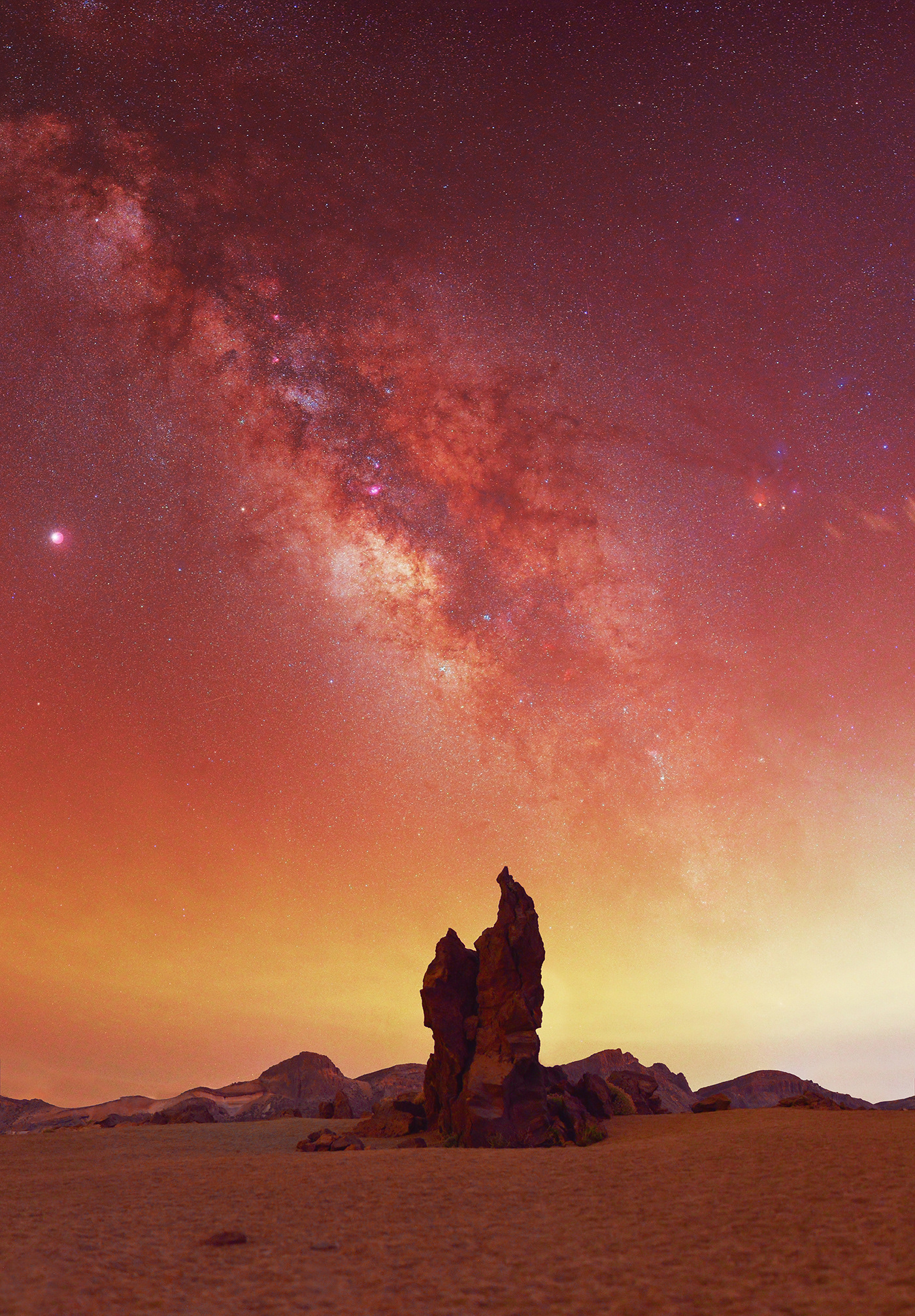






Roques de Garcia
When you pass through the Teide National Park, you will sooner or later recognize the Roques de Garcia. Without a doubt, it’s the most iconic and outstanding spot of the Cañadas, a famous landmark of Tenerife and one of the most impressive spots I could imagine to check out at night.
The numerous photogenic rocks that soar into the sky like giant dragon teeth are hinting an ancient volcanic history in the alien landscape of the Caldera de las Cañadas.
The numerous photogenic rocks that soar into the sky like giant dragon teeth are hinting an ancient volcanic history in the alien landscape of the Caldera de las Cañadas.
So I spent one night in between these rocks, starting my trip at the Mirador de la Ruleta downwards into the Ucanca Valley, just to get lost in the volcanic skyline for the whole night. There was so much to explore, so much to admire, to marvel and my flow with two cameras, a tracker and countless compositions that night was pure joy. The hours passed unnoticed until the morning when the rising moon changed the whole look of the scenery dramatically again. Such nights are rare, everything’s just works perfectly and by itself. Fabulous!



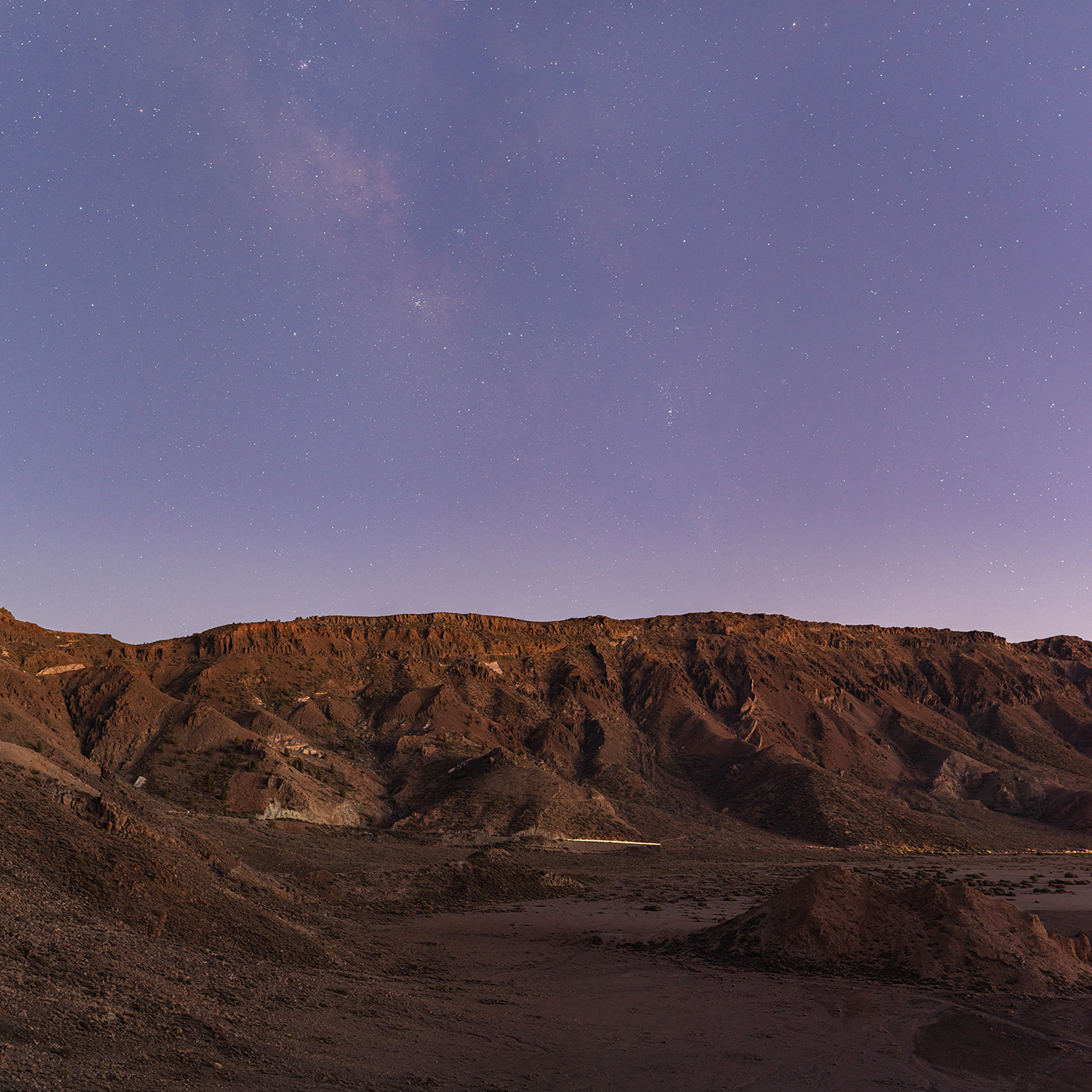


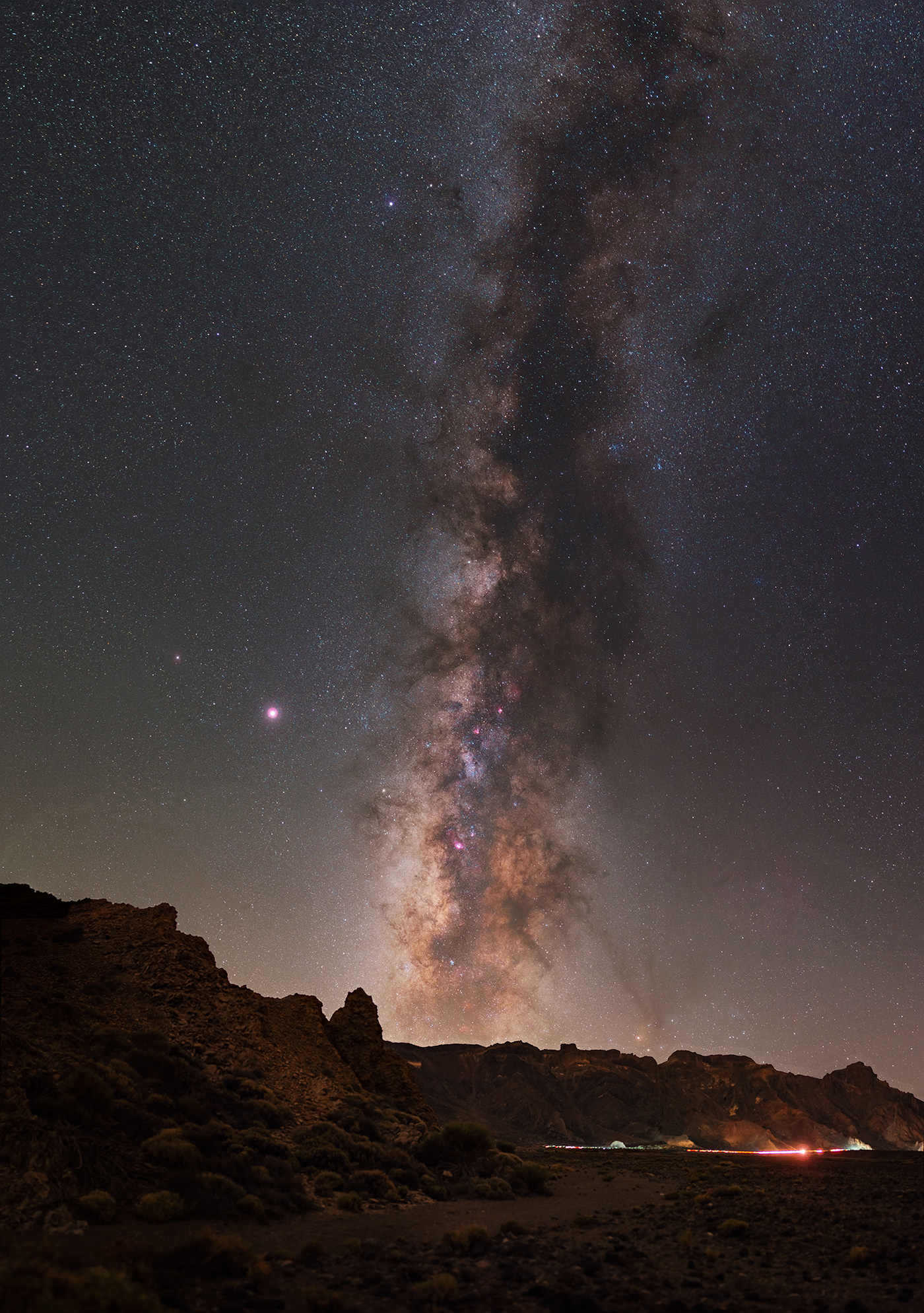
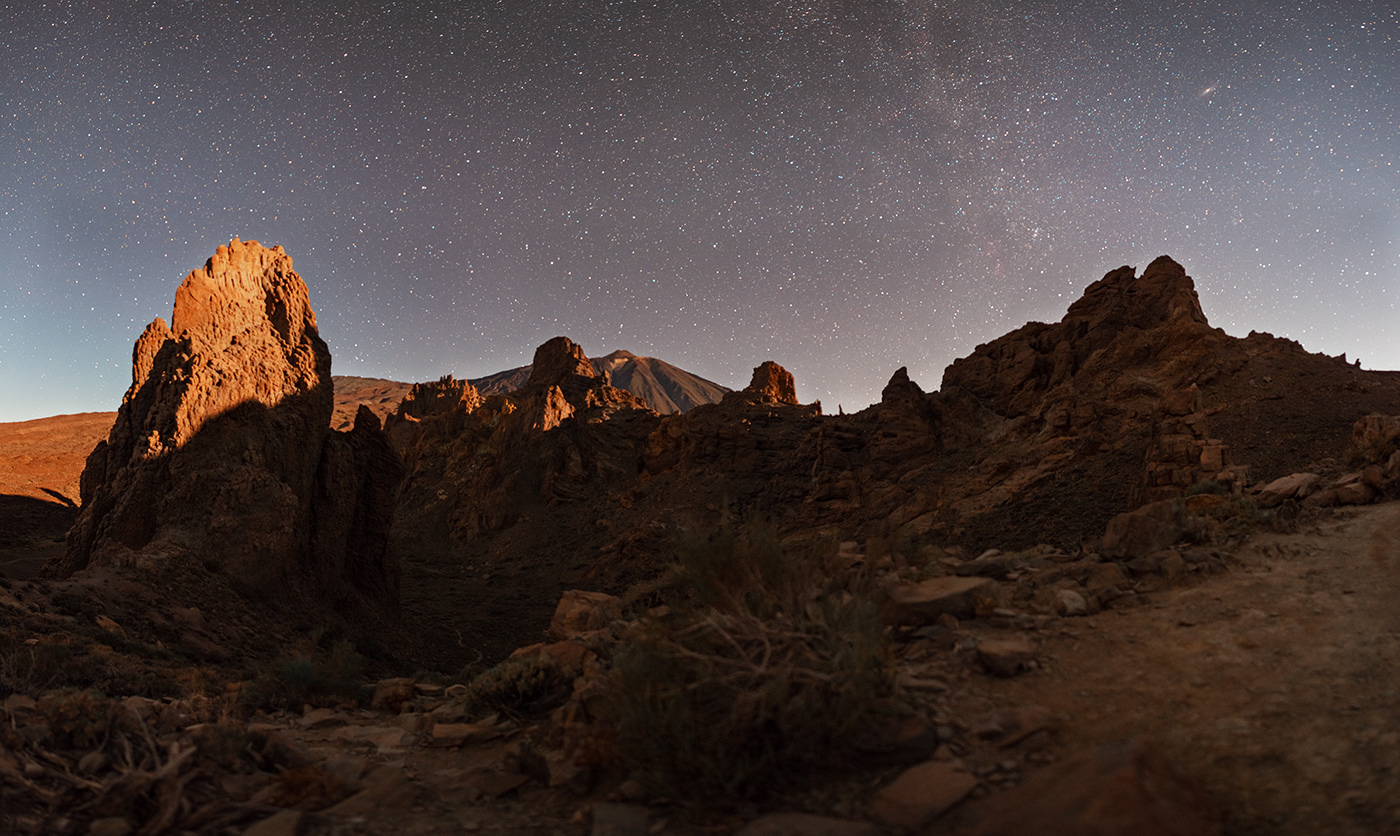

Llano de Ucanca & Perseid Meteor Shower 2020
The Perseid Meteor Shower had been the main reason for my trip to Tenerife. After scouting locations for 3 days and a few nights of photography, I felt ready and was absolutely excited. My chosen spot was in the Ucanca Valley at the Caldera las Cañadas del Teide with a perfect view at the famous Roques de Garcia and the mighty Teide. Perfecto! I dedicated two nights (August 11th to 13th) to get a blended Panorama of the Meteor Shower - consisting of around 1900 single images at 25 seconds exposure. It felt very cozy with a wonderful view in every direction while the Perseid Meteor Shower made me feel very melancholic again. To witness these timeless events in such geological time capsule was magnificently surreal, satisfying and peaceful. In the end, I had captured 43 Perseids (+ 1 Iridium Flare) including the famous green glow. It’s not as much as expected, but the quality, brightness and length of the Meteors was mind blowing and caused many wowzie moments.


EXIF: 2 Nights / 1903 Single Shots - Nikon D810 + Samyang 24mm / ISO 2000 - f/4 - 25s
While my Nikon D810 was busy collection Meteors for two nights, I started working on complex Panorama Images with my astromodified Nikon D800a Camera and longer focal lengths like 50mm & 85mm. My Vixen Polarie Star Tracker was a useful tool for my plan! So lets get started:
The center of the Milky Way is by far the most interesting, diversified, and photogenic region of the night sky as seen from planet Earth. You can find huge dark dust lanes, star clusters, colorful nebulae, and famous constellations like Sagittarius and Scorpius. As a photographer with a huge interest in the technical part of photography and tending to more complex panorama work - it’s a great joy to work with longer focal lengths and a star tracker on such a region in the night sky. The peak night of the Perseid Meteor Shower 2020 - August 12th/13th - was a good moment to go down the rabbit hole of such an exhausting photography project. My goal was to get a colorful and contrasty panorama of the Center of the Milky Way where the focus is more on the Galaxy than the landscape itself.
If you have to carry lots of gear and love to hike to remote spots at night, the Vixen Polarie Star Tracker is a good and lightweight choice to get some smooth long exposures. Luckily, it was mostly calm at the Ucanca Valley, so I got some crisp stars on-screen - even with 180s exposures and without any counterweight. At least at the beginning. To keep as much color details as possible, ISO 800 and an aperture f/4 where the basic settings - very low for astrophotography but the result speaks for itself.
This text is part of a behind-the-scenes story about that 85mm Panorama that I have written for LA based blog Framework Films in 2020

Panorama / Tracked - 20 Frames w/ Nikon D800a + Nikon AF-S 85mm f/1.8 & Vixen Polarie Star Tracker
ISO800 - f/4 - 180s ⠀
ISO800 - f/4 - 180s ⠀
Insights in the 85mm Milky Way Galaxy Long Exposure Panorama
The Los Angeles based creative media production agency @framework.films asked me to write an Article for their website including the background story of photographing and processing that tracked long exposure panorama taken with a long focal length and a modified camera. The shooting started quite good but slowly turned into a challenging battle with my gear and the conditions around.
Working with a focal length of 85mm was exciting and promising while the first test shoots revealed some extraordinary details of the galaxy’s dust lanes and nebulae. But if you work with such a sensitive and comparatively unprotected setup you never know how far you will get. I also need to mention, that I dont have a counter weight for my Tracker. Working with such a narrow lens you need many images to get a balanced good-looking Panorama - so there are many chances to mess up the whole project and go home empty-handed. In the end, there were twice as many fails of every panorama position on my card and I had to readjust and polar align my tracker again and again. Have you ever tried to protect your gear from soft wind holding your open jacket right behind your camera for three minutes, again and again, just to get one star trailed image after another on your screen? Sometimes it’s really hard but these challenges make such photography adventures so exciting and the final images so precious.
⠀⠀⠀⠀⠀⠀⠀⠀⠀⠀⠀⠀⠀⠀⠀⠀⠀⠀⠀⠀⠀⠀⠀⠀⠀⠀⠀ ⠀⠀⠀ ⠀⠀⠀
Now I take the chance to reveal a closer look on the images with it’s details, captions and succeeded vs failed raw frames. One have to keep in mind, that its challenging work and often tempting to just let it be. Dont despair, you will make it!
⠀⠀⠀⠀⠀⠀⠀⠀⠀⠀⠀⠀⠀⠀⠀⠀⠀⠀⠀⠀⠀⠀⠀⠀⠀⠀⠀ ⠀⠀⠀ ⠀⠀⠀
Now I take the chance to reveal a closer look on the images with it’s details, captions and succeeded vs failed raw frames. One have to keep in mind, that its challenging work and often tempting to just let it be. Dont despair, you will make it!






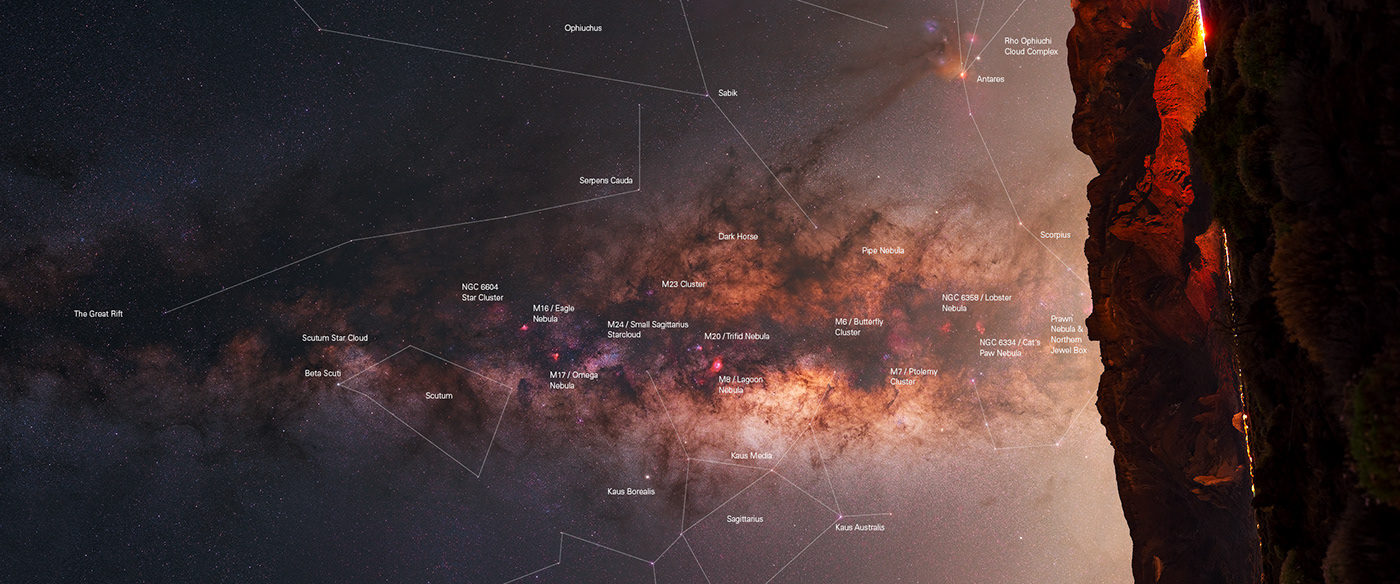
Final Image including a map of Stars, Nebulae & Constellations
Using tracked long exposures Images with an astromodified camera really pays off. You can achieve very much red h-alpha colour details within 90s. Wow! So I used the rest of the nights working on multi-long-exposure image panorama with 50mm focal length. You don’t get much images out of a night while working on such complex images, but I think the quality speaks for itself. I was happy and still got a handful of diversified Panorama.

Panorama - 20 Frames - Tracked / Blend - Nikon D800a & Nikkor AF-S 50mm f/1.8 + Vixen Polarie Star Tracker / ISO 800 - f/3.5 - 180sec
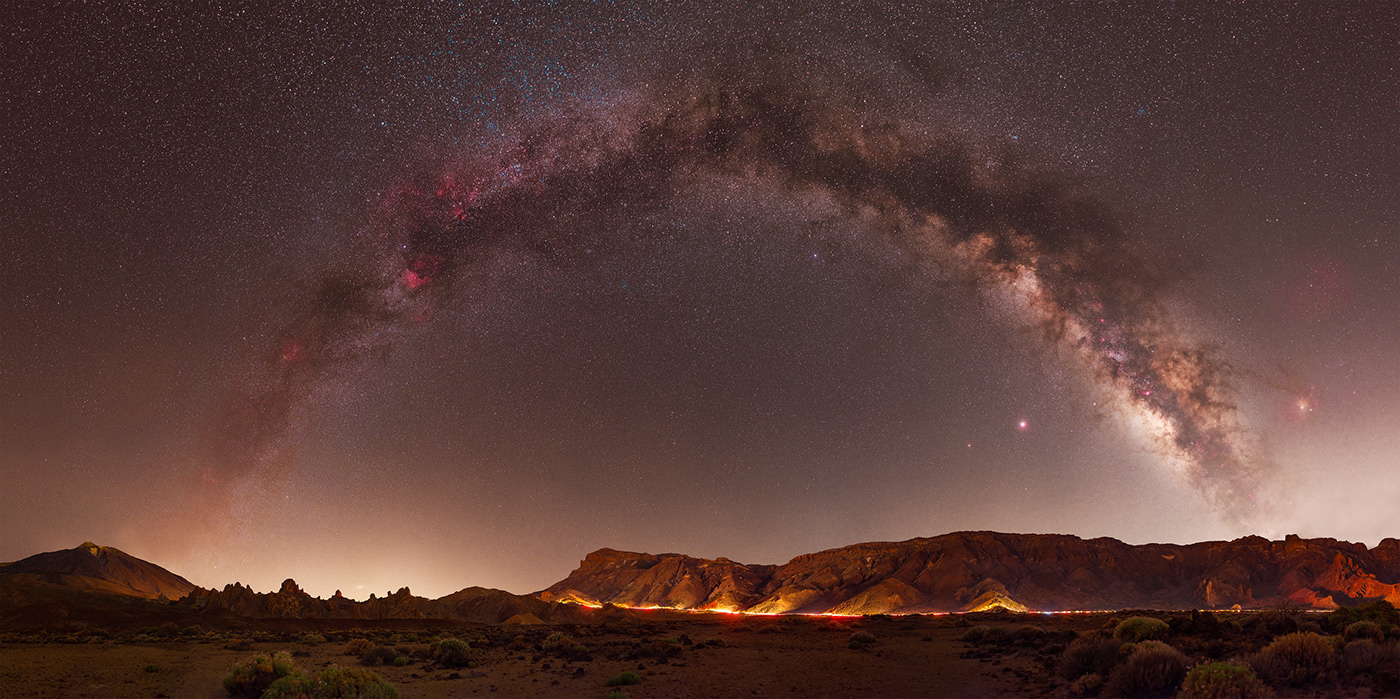
Panorama / Blend Nikon D800a + Nikon AF-S 50mm 130 Frames FG: ISO 2000 - f/2.8 - 30s Sky: ISO 4000 - f/2 - 10s

Panorama 46 Images - Nikon D800a & Nikkor 50mm f/1.8 + Vixen Polarie Star Tracker - ISO 4000 - f/2.2 - 30sec
Pico del Teide
After spending exciting nights of photography in the Cañadas of Tenerife, constantly looking at the giant Pico del Teide and the impressive aura of that volcano, I met Patrick, a very nice french guy who does nocturnal tours as a Mountain Guide. Together we ascended during a dark moonless night. „Hiking Teide at night is like meditation, just focus on breathing and your steps" he told me while both of us entered the dark trail at midnight.
It totally felt surreal to hike steeply upwards into complete darkness - even though I am used to nocturnal hikes for years. There, one just saw the starlight - the only reference points on a trail that meandered through former lava fields upwards that giant black volcano - the only thing that was darker then the surrounding night. We arrived right on time before sunrise at the summit - a magical crack of dawn in a surreal world - leaving the darkness with an amazing view. Unprotected by the freezing wind and disgusting smell of the extincted crater but with a well deserved feeling of exhaustion, unity and ecstasy. When the sun hit the horizon, the huge and perfectly shaped shadow of the Teide rose into the Atlantic Ocean. That’s the advantage of standing on top of the third highest volcano surrounded by the clouds above the Atlantic Ocean - an impressive, uninterrupted shadow almost kissing the horizon.
If you are interested, you can check dates for booking Patrick.




